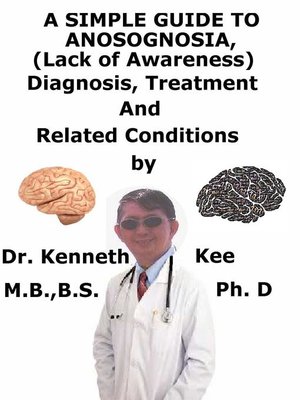A Simple Guide to Anosognosia, (Lack of Awareness) Diagnosis, Treatment and Related Conditions
ebook
By Kenneth Kee

Sign up to save your library
With an OverDrive account, you can save your favorite libraries for at-a-glance information about availability. Find out more about OverDrive accounts.
Find this title in Libby, the library reading app by OverDrive.



Search for a digital library with this title
Title found at these libraries:
| Library Name | Distance |
|---|---|
| Loading... |
This book describes Anosognosia (Lack of Awareness), Diagnosis and Treatment and Related Diseases
You may have read that the psychologist Mary Trump (Donald Trump's niece) uses the word Anosognosia in her book about her uncle "Too Much and Never Enough".
It often happens in people with schizophrenia, bipolar disease, dementia and stroke.
Anosognosia is the inability or refusal to recognize a defect or disorder that is evident.
People do not always feel comfortable admitting to themselves or others that they have a disorder they have been newly diagnosed with.
This is not abnormal and most people ultimately accept the diagnosis.
But occasionally, the rejection is long-lasting
It is not simply denial that is producing a person to reject the facts.
It is a disorder called anosognosia.
This roughly means "lack of awareness or insight" in Greek.
Anosognosia is a lack of ability to perceive the realities of one's own disorder.
It is a person's inability to accept that they have a disorder that matches up with their symptoms or a formal diagnosis.
This happens in spite of significant evidence of a diagnosis, and in spite of second and even third medical beliefs confirming the validity of a diagnosis.
Anosognosia is an effect of alterations to the brain.
It is not just obstinacy or total denial, which is a defense mechanism some people use when they acquire a difficult diagnosis to cope with.
In fact, anosognosia is central in disorders like schizophrenia or bipolar disorder.
Cause
Comparatively little has been found about the cause of the disorder since its initial identification.
Anosognosia develops from the physiological damage to brain structures, normally to the parietal lobe or a diffuse lesion on the fronto-temporal-parietal region in the right hemisphere
It is thus a neuropsychiatric disorder.
The perception of a person changes throughout the life.
When a patient has a new scar on the face, his or her brain needs to take it into account so that the patient remembers it is there when the patient looks in the mirror.
The frontal lobe is heavily affected in this continual process of reshaping the self-image.
Some mental health disorders can produce alterations in this part of the brain.
This produces frontal lobe tissue remodeling over time.
Ultimately, the patient may lose the ability to take in new information and renew the perception of the overall health.
Since the brain cannot grasp the newer information resulting from the disorder, the patient or the loved ones can become frustrated that the patient appears not to be taking the disorder seriously.
Risk factors
Anosognosia is frequent in people with serious mental illness.
Doctors think about 40% people with bipolar disorder and 50% with schizophrenia have it.
Some doctors believe the numbers are even greater.
They evaluate that anywhere from 57%-98% of people with schizophrenia have it.
Many people with neurological disorders have this disease.
It is not abnormal for some person with Alzheimer's to get it.
Stroke patients often get it too.
Anosognosia treatment involves treating the underlying cause.
Studies indicate that about 33% of people with schizophrenia improve in consciousness of their illness when they take antipsychotic medicine.
Studies also indicate that a larger percentage of people with bipolar disorder improve on medicine.
Most instances of anosognosia seem to simply disappear over time, while other instances can persist indefinitely.
Normally, the long-term patients are...







